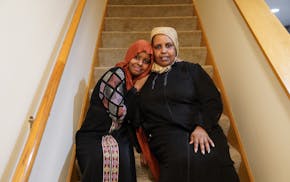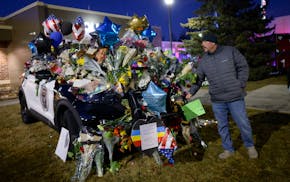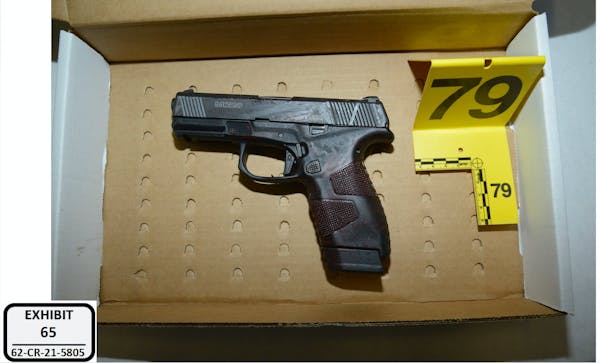The guns used last week to end four lives in Burnsville and rip a community's fabric should have never been in the hands of the man who unleashed more than 100 rifle rounds during an hourslong standoff that took place while children were inside the home.
It is still not publicly known what specific types of firearms or ammunition Shannon Cortez Gooden used to kill two Burnsville police officers, the paramedic who tried to save them and himself. But whatever weapons the 38-year-old man reached for he was barred by law from possessing, based on a previous assault conviction.
The Minnesota Bureau of Criminal Apprehension (BCA) — with assistance from federal law enforcement — is examining how Gooden accessed the multiple firearms and arsenal of ammunition he deployed in the chaotic standoff at his home on Feb. 18. But opportunities are vast for people prohibited from having guns to get their hands on them, and those ordered to relinquish their firearms are often bound by an imperfect enforcement process criticized by some as an "honor system."
"If I had 100 defendants in my courtroom and I told them all that they have one hour to go buy a firearm and get back to the courtroom, 95 of them could do it," said Chief U.S. District Judge Patrick Schiltz.
Both state and federal law carve out prohibitions for gun ownership in cases such as felony convictions, misdemeanor domestic violence convictions, involuntary commitments for mental illness and controlled substance abuse.
People prohibited from owning guns or ammunition can still obtain weapons through theft, buying ones illegally trafficked or through "straw purchasing" – where they enlist another person legally able to buy firearms to do so on their behalf, a state and federal crime. Law enforcement in recent years have also increasingly investigated cases involving privately made firearms, or ghost guns, which can be assembled at home and often without serial numbers.
The BCA has not disclosed how or when Gooden acquired the guns he used. One of the two women with whom Gooden had children, and who was not living with Gooden, told the Star Tribune on Friday that she did not know how he obtained the guns and only learned about him possessing them after the shooting.
The agency said Thursday that Gooden fired more than 100 rifle rounds at law enforcement and first responders called to his home just before 2 a.m. on Feb. 18 after reports of a domestic incident. Officers Matthew Ruge and Paul Elmstrand and firefighter/paramedic Adam Finseth were killed. Gooden took his own life with a gun, but not before firing at other officers and an armored vehicle.
Court records show that Gooden was convicted in February 2008 of second-degree assault with a dangerous weapon for brandishing a knife and throwing rocks during a fight in a Burnsville shopping center parking lot months earlier. Gooden's conviction was eventually reduced from a felony to a misdemeanor because he abided by the terms of probation. The order restored his right to vote, but he was barred for life from owning firearms.
He unsuccessfully petitioned to regain his gun rights in August 2020, explaining that he wanted to protect himself and his family. The Dakota County Attorney's Office opposed the request, pointing to two orders for protection that had been filed against him by women with whom he shared children. Neither woman successfully obtained an order for protection. In a 2017 filing, the woman failed to appear for a hearing. A judge dismissed the second petition for lack of evidence.
Inconsistent methods
Thomas Chittum, a former second-in-command at the federal Bureau of Alcohol, Tobacco, Firearms and Explosives (ATF) and now an executive at SoundThinking, the gunfire sound location service formerly known as ShotSpotter, said the criminal justice system is inconsistent in trying to ensure that those barred from owning guns relinquish their firearms. Too often, he said, law enforcement "just trusts that they have."
"A very small minority of jurisdictions actually have some proactive approach to ensuring someone has divested," Chittum said. "In most places, there is no formal mechanism. It's a place where I think law enforcement, public safety and the courts could make significant strides."
Lindsay Nichols, policy director for the Giffords Law Center to Prevent Gun Violence, also expressed concern that not enough is being done nationwide to see that people actually relinquish guns when courts order it.
"It requires a dedicated effort on the part of the courts and law enforcement," Nichols said. "The system really needs to be set up to notify the person about ways they can relinquish their guns and to ensure that they do."
Research out of the state of Washington published last year in the journal Criminology & Public Policy pointed to the need for stronger enforcement of firearms removal from people under civil protection orders or criminally convicted of domestic violence to reduce the potential for gun deaths and injuries among domestic violence victims.
The study found that local jurisdictions were challenged in implementing and enforcing orders barring people from possessing firearms. In many cases, compliance was solely based on an "honor system." There is a specialized unit in King County, Washington, which includes Seattle, that makes sure firearm surrender orders are followed. It's a resource-intensive endeavor requiring law enforcement, prosecutors, advocates, a court order expert and other staffers.
Nichols identified one of two major DFL-backed gun measures to take effect this year as an important step to close a loophole she said allowed prohibited persons to get guns. Under the new law, background checks must be performed even in private gun transfers involving sellers who are not federally licensed dealers.
State Rep. Dave Pinto, DFL-St. Paul, said the expanded background check law choked off a major path for guns to be used in crimes. Pinto and other Minnesota Democrats are now backing new legislative proposals to require secure storage of firearms and a requirement that gun owners report lost or stolen firearms to authorities.
"That is part of the process of ensuring the guns don't end up in the hands of people who show themselves to be dangerous," Pinto said.
As of Jan. 1, Minnesota also has a new extreme risk protection order – or "red flag" – law that allows people or law enforcement to petition a judge to take firearms away from a person deemed to be a danger to themselves or others. Since Minnesota's red flag law went into effect, judges across the state have received 18 petitions and granted eight, according to the Minnesota Judicial Branch.
Republican state lawmakers are proposing enhanced penalties for repeat offenders and a measure to ensure follow up to remove firearms from those with domestic abuse backgrounds who have been ordered by a judge to surrender the weapons.
"We need to support all aspects of our criminal justice system with adequate resources, and then hold prosecutors, judges, and law enforcement accountable to fully charge, sentence, and follow through on any judgments made to keep the community safe," said state Sen. Michael Kreun, R-Blaine, who is sponsoring the latter bill.
State Rep. Paul Novotny, R-Elk River, a retired sheriff's office sergeant, backs a public education campaign on straw purchasing. Citing the Burnsville shooting, Novotny said he is also going to call on the state's largest county attorneys' offices to start releasing data on the origin of guns used in crimes.
State Sen. Ron Latz, the St. Louis Park Democrat who chairs the Senate's Judiciary and Public Safety Committee, said he supported examining Kreun's proposal, but he questioned whether the state's criminal justice system had enough resources for such a mandate.
"The ability to stop gun violence or reduce gun violence is a function of just so many pieces in the puzzle and we pass things that add pieces, but there isn't any one magic wand that you can wave that's going to solve the problem," Latz said.
The Bureau of Alcohol, Tobacco, Firearms and Explosives is meanwhile trying to carry out as much education for licensed gun sellers and owners as it does enforcement operations – particularly the signs of suspected straw purchasing.
"It's an ongoing issue, that constant balancing act of enforcing whatever statutes that we're looking at on firearms and also protecting Second Amendment rights. It's a fine line," said Travis Riddle, special agent in charge of the ATF's St. Paul division. "We have great discretion on prosecutions on what we seek sometimes prosecution is not the best avenue, sometimes it's just education."
Schiltz, the chief federal judge, said it's up to defendants in federal cases to figure out how to get rid of any guns once they become prohibited. Even when someone is under supervised release after leaving prison, they are one of dozens or more people assigned to a given probation officer. The officers can search homes but, Schiltz said, "they're not opening every drawer, they're not looking through luggage."
"It would be very, very easy for someone to possess a firearm and it not be spotted by the probation officer," Schiltz said. "Even though in theory there's closer supervision and there's that extra layer of protection, in reality it has very little deterrent effect on somebody who wants to possess a firearm."
Star Tribune staff writer Paul Walsh contributed to this report.

Growth in Somali culture programs aims to address second-generation language loss

Two Minnesota children in 1870 were lost in the woods, but not to history
In Rice County, which backed Trump, officials have spent years battling groups over voting machines

Ensuring those barred from owning guns don't get them comes down to 'honor system'


